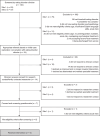Guided Self-Help Treatment for Children and Young People With Eating Disorders: A Proof-Of-Concept Pilot Study
- PMID: 39748198
- PMCID: PMC11965551
- DOI: 10.1002/erv.3171
Guided Self-Help Treatment for Children and Young People With Eating Disorders: A Proof-Of-Concept Pilot Study
Abstract
Objective: To conduct a proof-of-concept pilot study of a CBT guided self-help intervention for children and young people with eating disorders.
Method: Children and young people were recruited from two outpatient eating disorder services in England. They received a CBT guided self-help intervention consisting of eight modules and weekly support sessions. Clinical outcomes (eating disorder psychopathology and associated impairment, changes in %median BMI, depression, anxiety, and behavioural difficulties) were assessed at baseline and post-intervention (12 weeks). Qualitative data were collected for future intervention refinement.
Results: Six female adolescents (aged 13-17) received the CBT guided self-help intervention. All participants completed a minimum of six modules and six support sessions. Quantitative and qualitative feedback suggested that the intervention was acceptable. From baseline to post-intervention, there was a reduction in eating disorder psychopathology and impairment, along with an increase in %median BMI. Outcomes for depression, anxiety and behavioural difficulties were mixed.
Conclusions: The CBT guided self-help intervention was feasibly implemented, acceptable to participants, and showed potential to produce clinical benefits. While promising, these findings are preliminary and derived from a small, non-randomised sample of White female adolescents. More rigorous evaluation with a randomised design and a larger, representative sample is warranted.
Keywords: children and young people; eating disorders; guided self‐help; low intensity; pilot study.
© 2025 The Author(s). European Eating Disorders Review published by Eating Disorders Association and John Wiley & Sons Ltd.
Conflict of interest statement
The authors declare no conflicts of interest.
Figures
Similar articles
-
Guided self-help treatment for children and young people with threshold and subthreshold eating disorders: A pilot study protocol.PLoS One. 2024 Apr 16;19(4):e0301606. doi: 10.1371/journal.pone.0301606. eCollection 2024. PLoS One. 2024. PMID: 38625953 Free PMC article.
-
Programme-Led and Focused Interventions for Recent Onset Binge/Purge Eating Disorders: Use and Outcomes in the First Episode Rapid Early Intervention for Eating Disorders (FREED) Network.Int J Eat Disord. 2025 Feb;58(2):389-399. doi: 10.1002/eat.24343. Epub 2024 Nov 30. Int J Eat Disord. 2025. PMID: 39614775 Free PMC article.
-
Brief cognitive behavioural therapy for eating disorders symptomatology among a mixed sample of adolescents and young adults in primary care: A non-randomised feasibility and pilot study.Eur Eat Disord Rev. 2024 Jul;32(4):676-686. doi: 10.1002/erv.3075. Epub 2024 Feb 27. Eur Eat Disord Rev. 2024. PMID: 38413477
-
A comparison of the effectiveness of cognitive behavioural interventions based on delivery features for elevated symptoms of depression in adolescents: A systematic review.Campbell Syst Rev. 2024 Jan 7;20(1):e1376. doi: 10.1002/cl2.1376. eCollection 2024 Mar. Campbell Syst Rev. 2024. PMID: 38188230 Free PMC article. Review.
-
Mental Health Impacts of Self-Help Interventions for the Treatment and Prevention of Eating Disorders. A Meta-Analysis.Int J Eat Disord. 2025 May;58(5):815-831. doi: 10.1002/eat.24405. Epub 2025 Mar 3. Int J Eat Disord. 2025. PMID: 40026263 Free PMC article. Review.
References
-
- Accurso, E. C. , and Waller G.. 2021. “A Brief Session‐By‐Session Measure of Eating Disorder Psychopathology for Children and Adolescents: Development and Psychometric Properties of the Eating Disorder‐15 for Youth (ED‐15‐Y).” International Journal of Eating Disorders 54, no. 4: 569–577. 10.1002/eat.23449. - DOI - PMC - PubMed
-
- Beat . 2015. The Costs of Eating Disorders: Social, Health and Economic Impacts. https://www.basw.co.uk/system/files/resources/basw_54403‐3_0.pdf.
-
- Bennett, S. D. , Cuijpers P., Ebert D. D., et al. 2019. “Practitioner Review: Unguided and Guided Self‐Help Interventions for Common Mental Health Disorders in Children and Adolescents: A Systematic Review and Meta‐Analysis.” Journal of Child Psychology and Psychiatry 60, no. 8: 828–847. 10.1111/jcpp.13010. - DOI - PubMed
MeSH terms
Grants and funding
- UCL Great Ormond Street Institute of Child Health
- Child Health Research PhD Studentship at UCL Great Ormond Street Institute of Child Health
- Great Ormond Street Hospital NHS Foundation Trust and UCL Great Ormond Street Institute of Child Health
- National Institute of Health Research
- Great Ormond Street Hospital Biomedical Research Center
LinkOut - more resources
Full Text Sources
Medical


